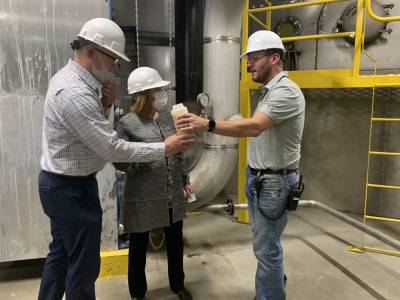For farmers and ranchers, Rural Development is one of the most little-known USDA agencies – even though its multibillion-dollar portfolio spans all states and territories, providing a broad range of crucial grant and loan programs to rural areas. These programs include grant funding and loan financing for water/wastewater infrastructure, community facilities, broadband, electric, telephone, housing, renewable energy and business development.
But the agency has not been without controversy, including when Ag Secretary Sonny Perdue decided not to give what had traditionally been the top rank and title of undersecretary to the person leading the mission area. In 2017, Perdue named Anne Hazlett to lead rural development with the title of Assistant to the Secretary and explained that he was limited by law on the number of undersecretaries that he could name.
Congress disagreed and recreated the position of undersecretary for rural development in the 2018 farm bill.
There’s still no undersecretary at the agency, but since February of this year, it’s been led by Deputy Undersecretary Bette Brand. Prior to her appointment, Brand served as the Administrator of Rural Development’s Rural Business Service agency. She came to USDA after 35 years with Farm Credit of the Virginias, where she served as chief advocate for the agriculture industry and rural businesses. Prior to this, Brand served as chief sales officer, overseeing the business development of a $1.6 billion credit portfolio, managing a team of commercial agriculture and agribusiness lenders, and supervising the association’s marketing and branding. She’s now managing an even larger portfolio.
In an interview with Agri-Pulse, Brand says despite most employees working remotely, her mission area is experiencing a “paramount year,” with the highest number of loan and grant obligations since 2010. USDA estimates Rural Development obligated a total of $39.7 billion in loans and grants this year.
“The field offices have done an incredible job and continue to be committed. And we've also done some strategic realignment in this administration, with the Central Business Center, the creation of the Innovation Center, and those sorts of things that have really, really helped us continue operating and serving our customers during COVID,” she explained.
Some of the questions and answers have been edited for brevity and clarity.
Agri-Pulse: Can you elaborate on the realignment and restructuring that you've done?
Brand: We've restructured our single-family housing guarantee program and are able to streamline and have consistency across the country. The way we are structured now helps us get these applications in and out on a much quicker basis and respond to our lenders much quicker. We've had one of the highest numbers in the single-family guarantee program in a very long time. Likewise, the Rural Business Cooperative Service was realigned, as well as two of our guaranteed programs, the Rural Energy for America Program (REAP) and the Business and Industry (BNI) program. We were able to streamline processes and have more bench strength in our office here. When loans have to come up to the national office because they exceed the delegated authority, the team up is much more coordinated because of these realignments.
You’ve also launched the “One RD Guarantee Program.” How does that work?
It became effective Oct. 1, and provides a common application process for four major guarantee programs: the Water and Waste Disposal loan guarantee program, the Community Facilities guarantee program, the Business and Industry guarantee program, and the REAP guarantee program. It standardizes the requirements for credit reviews, loan processing, loan servicing, loss claims, those sorts of things. The new regulation took over a year to develop. We hosted many webinars to communicate with lenders about the programs and to iron out sticking points that were unique to each program. We were able to clean up the language and make it much more consistent across all four programs. With that, there's a commitment to be more responsive and provide an answer back to lenders. Once we have all the required information in, we have promised them 48-hour turnaround time. A lot of good things have come about, even though most of the team was working remotely. It really will help the people we serve.
Is your team fully staffed now?
We are not; we have a hiring plan that we are working towards and we've done some really creative things in that regard. We’ve figured out how to hire and onboard people remotely. Just last week, our HR department hosted a virtual recruitment fair through LinkedIn and had good success. This is probably a much broader, more accessible way for people to look for opportunities here at RD. And we're really happy. According to USDA, the RD staffing breakdown goes as follows: In FY20: RD had 4,272 full-time employees; In FY19: 4,385; in FY18: 4,589; and in FY17: 4,973. (USDA Rural Development’s new career website is here.)
The ability to have broadband access is so critically important. What’s the status of the grants and loans you are providing to connect Rural America?
Broadband has certainly been a priority of rural development – it's not just something nice to have anymore, it is definitely a necessity. There's approximately 21 million Americans without access to high speed internet. Of those, 80% are in rural areas or tribal land. We're still really focused on that. Today, we have invested $827.8 million in the Reconnect program. In round one, we invested $698 million in 82 projects. And those included 167,000 households, 17,000 rural small businesses and farms, and more than 500 health care centers, educational centers, and community critical community facilities in 33 states. In round two, we have 172 applications. And of those, 11 are eligible for the hundred million dollars that Congress allocated through the CARES act. USDA has announced $129.7 million and we have more to come. We would like to see that expanded beyond and include all the states and territories.

Brand tours Siouxland Energy Cooperative
You received some additional money from Congress for distance learning and telemedicine. How are these funds being used?
We received 534 applications for the additional $25 million that we got through the CARES Act; those applications totaled $252.1 million. So pretty close to 10 times the request for the dollar amount that we had. Of those that we received, it's just amazing. I was in Sioux Falls, South Dakota, two weeks ago and visited Avera, a regional health care system serving South Dakota, Minnesota, Iowa, Nebraska and North Dakota. It is amazing. We talked to another health care facility in Iowa, and to an individual working in Sioux Center Health. These rural health care facilities are connected virtually to a hospital in Sioux Falls through what Avera calls eCare using interactive videos. It provides that extra colleague, whether it be a nurse or a doctor, and certainly helps increase the quality of health care provided in these rural communities. And we know it's hard to keep doctors and nurses in a lot of these rural health care centers. Through this eCare, they are able to use telemedicine to provide that colleague support when they need it. And they're finding that it actually results in medical professionals staying in those smaller communities. Certainly, the pandemic has really exacerbated the need for that, but I think we will see those benefits last way beyond the pandemic.
What else would you like farmers, ranchers and small business owners to know about access to RD programs?
First off, I want people to know that we are open for business and anyone can go to https://www.rd.usda.gov/, find the name and number of the state director, and they will put them in touch with the right specialist. RD has innovated the way we interact with our customers and rolled out programs through standardized toolkits and online outreach. We’ve hosted 74 webinars with more than 13,400 participants, including 32 COVID-related webinars reaching 6,400 participants. We are trying to get more award announcements out so hopefully, someone will see themselves in the shoes of that award recipient and ask us about how it might work for them. We're more in the thought process of – tell us what you're trying to solve and we will get the team together to help you solve that – rather than having people memorize all our different programs and trying to see if they fit in. It can be overwhelming, because there's so many programs. For example, RD announced a $250,000 investment to help Stensland Creamery in Larchwood, Iowa, launch sales of frozen pizza – the dairy’s newest value-added product. This funding award was made through the Value-Added Producer Grant Program. Stensland Creamery will use USDA funding for working capital to expand the marketing and sales of pizza made with cheese produced by the Stensland dairy. In another case, the agency partnered with American State Bank to invest $8 million in Siouxland Energy Cooperative. This USDA Rural Development Business and Industry Loan Guarantee CARES Act investment will be used to provide working capital for Siouxland Energy Cooperative, a 90-million-gallon-per-year ethanol plant that has been in operation since 2000. I am very passionate about rural communities. I grew up, I worked in rural communities. And when we say that, when rural America thrives, all America thrives. It is so true.
For more news, go to: www.Agri-Pulse.com


